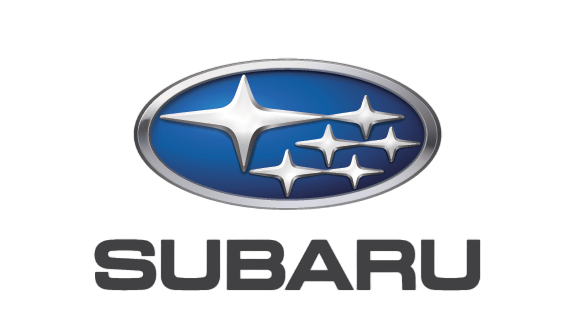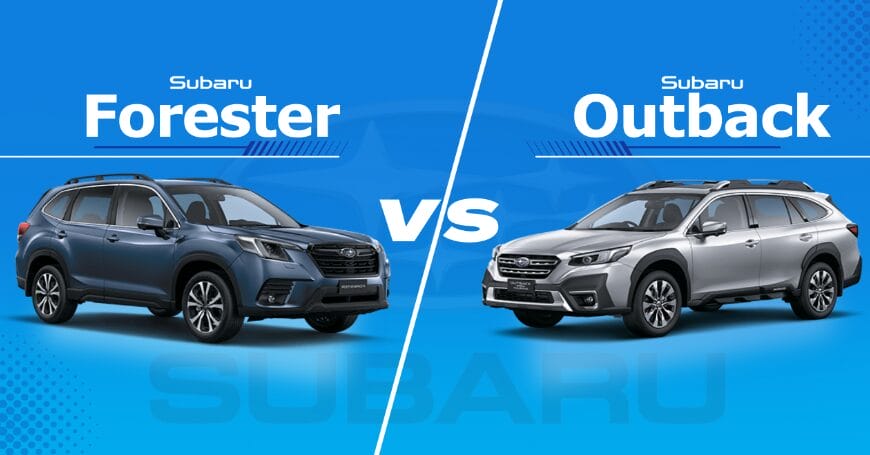Choosing between the Subaru Forester and the Subaru Outback can be a tough decision for prospective buyers. Each model offers distinct advantages: the Forester is renowned for its agility and off-road capability, appealing to adventurers, while the Outback offers a smoother ride with wagon-like comfort, ideal for long road trips and daily commutes.
This comparison delves into their key features, performance, and technology to help you decide which Subaru best suits your needs..
What are the Key Features of the Subaru Forester?
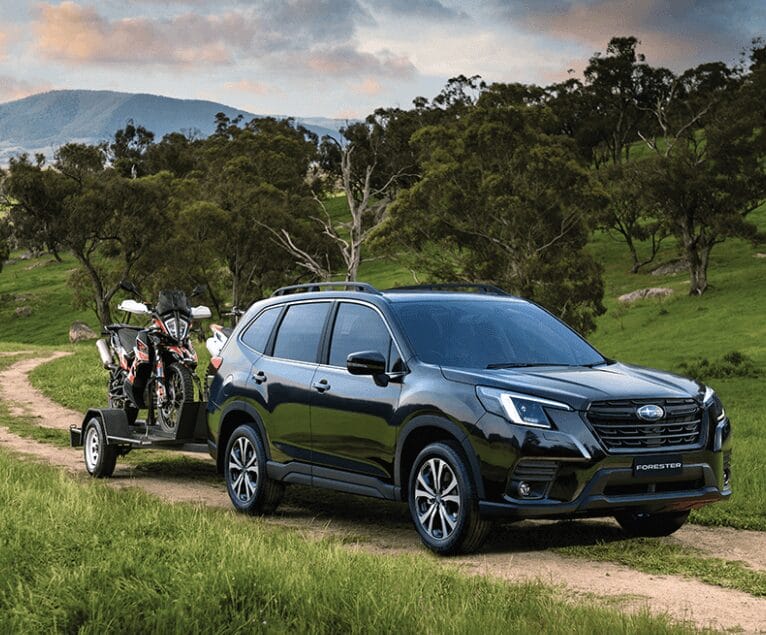
The Subaru Forester is a compact SUV renowned for its combination of durability, versatility, and advanced technology. Key features include a robust all-wheel drive system, a spacious and functional interior, cutting-edge safety technologies through Subaru’s EyeSight Driver Assist, and a potent 2.5-litre engine. It delivers a balanced ride with responsive handling, suitable for both urban environments and rugged landscapes. The Forester also integrates Subaru’s latest infotainment system, enhancing connectivity and overall driving experience. These attributes, along with Subaru’s commitment to reliability, establish the Forester as a formidable competitor in its segment.
What Sets the Subaru Outback Apart?
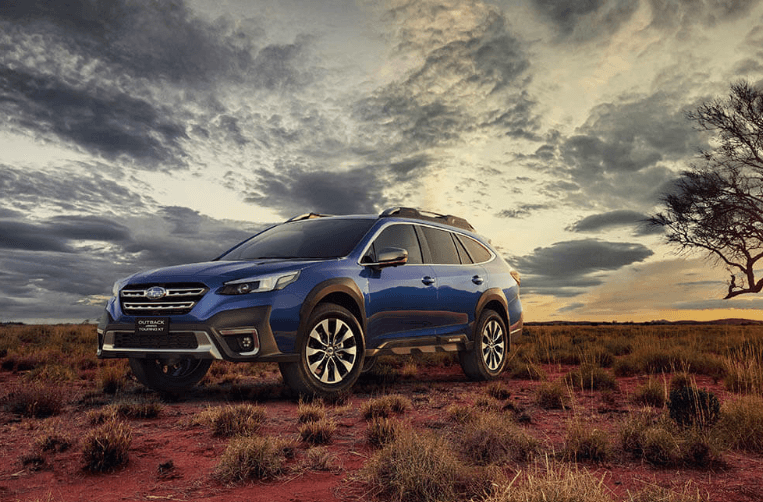
The Subaru Outback stands out in the large SUV market with its unique blend of comfort and off-road capabilities.
Distinctive features include a rugged exterior design, an exceptionally roomy and upscale interior, and a suite of advanced safety technologies, including the reliable EyeSight Driver Assist system. The Outback boasts a smooth and substantial ride, supported by a robust all-wheel-drive system, making it adept at handling both city streets and more challenging terrain. Additionally, the Outback is equipped with Subaru’s latest infotainment system, ensuring enhanced connectivity and an engaging user experience. These qualities, combined with Subaru’s emphasis on durability and comfort, make the Outback a leading choice in its class.
Capacities & Dimensions: Subaru Forester vs Outback
Boot Space, Size, Luggage Capacity, and Cargo Space
| Forester Models | Seats Configuration | Cargo Volume Rear Seats Up (L) | Cargo Volume Rear Seats Down (L) | Total Cargo to Ceiling (L) |
| Subaru Forester 2.5i AWD | 5-seater, 60/40 split | 498 | 1060 | 1768 |
| Subaru Forester 2.5i-L AWD | 5-seater, 60/40 split | 498 | 1060 | 1768 |
| Subaru Forester 2.5i Premium AWD | 5-seater, 60/40 split | 498 | 1060 | 1768 |
| Subaru Forester 2.5i Sport AWD | 5-seater, 60/40 split | 498 | 1060 | 1740 |
| Subaru Forester 2.5i-S AWD | 5-seater, 60/40 split | 498 | 1060 | 1740 |
| Subaru Forester Hybrid L AWD | 5-seater, 60/40 split | 509 | 1071 | 1779 |
| Subaru Forester Hybrid S AWD | 5-seater, 60/40 split | 509 | 1071 | 1779 |
| Outback Models | Seats Configuration | Cargo Volume Rear Seats Up (L) | Cargo Volume Rear Seats Down (L) | Total Cargo to Ceiling (L) |
| Subaru Outback AWD | 5-seater, 60/40 split | 522 | 1267 | 1383 |
| Subaru Outback AWD Sport | 5-seater, 60/40 split | 522 | 1267 | 1783 |
| Subaru Outback AWD Touring | 5-seater, 60/40 split | 522 | 1267 | 1711 |
| Subaru Outback AWD Sport XT | 5-seater, 60/40 split | 522 | 1267 | 1783 |
| Subaru Outback AWD Touring XT | 5-seater, 60/40 split | 522 | 1267 | 1711 |
Length, Width, and Height: Forester vs Outback
The Subaru Forester offers compact dimensions ideal for diverse terrains, with an overall length of 4640 mm, width of 1815 mm, and height of 1730 mm. The wheelbase measures 2670 mm, ensuring a spacious interior and stable handling. Notably, it features a high ground clearance of 220 mm, excellent for off-road capability.
In contrast, the Subaru Outback is larger, suited for enhanced comfort on long journeys, measuring 4870 mm in length and 1875 mm in width. Heights vary by model between 1670 mm and 1675 mm. The Outback boasts a longer wheelbase of 2745 mm, facilitating a more expansive cabin space and a slightly lower ground clearance of 213 mm, tailored for comfort and stability.
Performance, Engine Types, and Fuel Economy: Subaru Forester vs Outback
The Subaru Forester and Outback models offer a range of engine types and fuel efficiencies that cater to different driving preferences and requirements. Here, we will explore the variations in engine specifications and fuel economy between these two popular Subaru models.
| Forester Models | Engine Type | Fuel Consumption (L/100km) | Fuel Tank (L) |
| Subaru Forester 2.5i AWD | Direct injected, Boxer 4-cylinder, petrol | 7.4 | 63 |
| Subaru Forester 2.5i-L AWD | Direct injected, Boxer 4-cylinder, petrol | 7.4 | 63 |
| Subaru Forester 2.5i Premium AWD | Direct injected, Boxer 4-cylinder, petrol | 7.4 | 63 |
| Subaru Forester 2.5i Sport AWD | Direct injected, Boxer 4-cylinder, petrol | 7.4 | 63 |
| Subaru Forester 2.5i-S AWD | Direct injected, Boxer 4-cylinder, petrol | 7.4 | 63 |
| Subaru Forester Hybrid L AWD | Direct injected, e-Boxer 4-cylinder, petrol | 6.7 | 48 |
| Subaru Forester Hybrid S AWD | Direct injected, e-Boxer 4-cylinder, petrol | 6.7 | 48 |
| Outback Models | Engine Type | Fuel Consumption (L/100km) | Fuel Tank (L) |
| Subaru Outback AWD | Direct injected, Boxer 4-cylinder, petrol | 7.3 | 63 |
| Subaru Outback AWD Sport | Direct injected, Boxer 4-cylinder, petrol | 7.3 | 63 |
| Subaru Outback AWD Touring | Direct injected, Boxer 4-cylinder, petrol | 7.3 | 63 |
| Subaru Outback AWD Sport XT | Turbocharged, Boxer 4-cylinder, petrol | 9 | 63 |
| Subaru Outback AWD Touring XT | Turbocharged, Boxer 4-cylinder, petrol | 9 | 63 |
Safety and Technology: Which Subaru is More Advanced?
Safety and EyeSight: Forester Vs Outback
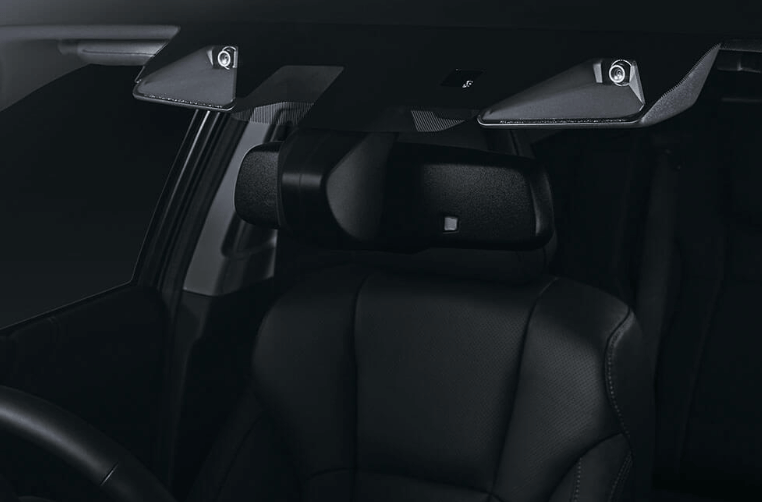
Both the Subaru Forester and Subaru Outback are highly regarded for their safety features, each boasting a 5-star ANCAP safety rating that underscores their commitment to protecting passengers.
Central to their safety capabilities is the Subaru EyeSight Driver Assist System, which is standard across both models. This advanced system includes adaptive cruise control, pre-collision braking, lane departure and sway warning, and lane keep assist.
These features work together to enhance the driving experience, making both the Forester and Outback safer choices for families and individuals alike. The integration of these intelligent systems demonstrates Subaru’s proactive approach to vehicular safety, providing drivers with added peace of mind on the road.
Infotainment and Technology: Forester Vs Outback
The Subaru Forester and Outback are both equipped with state-of-the-art infotainment systems that enhance the overall driving and user experience. The Forester features an integrated infotainment system that includes an 8-inch touchscreen. This system supports Bluetooth® wireless technology for hands-free mobile communication and audio streaming. It also offers seamless smartphone integration with Apple CarPlay® and Android Auto™ connectivity, ensuring drivers can safely access their music, navigation, and other apps while on the move.
In contrast, the Subaru Outback steps up the technology game with a more expansive centre information display that features an 11.6-inch touchscreen, providing a larger visual and control interface. Like the Forester, it includes Bluetooth® wireless technology for hands-free calls and audio streaming. Additionally, the Outback offers wireless versions of Apple CarPlay® and Android Auto™, allowing for even easier connectivity without the need for cables. This upgrade not only enhances the aesthetic appeal of the Outback’s cabin but also improves functionality, making technology access more convenient and intuitive.
Price Comparison: Which Car is More Affordable?
The Subaru Forester offers a more budget-friendly entry point at a driveaway price of $43,962, making it an attractive option for cost-conscious buyers. In comparison, the Subaru Outback starts at $49,556 driveaway, reflecting its larger size and more advanced features. This price difference highlights the Forester as the more economical choice for those looking to balance affordability with the reliable quality Subaru is known for.
Which Subaru Model is Right for You?
Choosing between the Subaru Forester and the Subaru Outback boils down to your specific needs and preferences. The Forester offers affordability and robust features, making it ideal for daily drives and light adventures. The Outback, with its larger size and advanced technology, caters to those seeking extra comfort and a premium feel. Both models showcase Subaru’s commitment to safety and quality.
To determine which model fits your lifestyle, we recommend a firsthand experience. Visit Perth City Subaru dealer to explore and compare these outstanding vehicles. Book a test drive today and decide whether the Subaru Forester or the Subaru Outback is the perfect choice for you.
